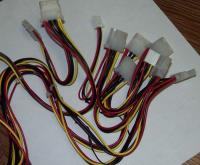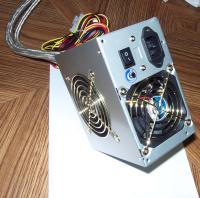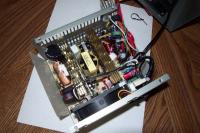4-Way Power Supply Shootout: Vantec, Enermax, ThermalTake, Antec
by Kristopher Kubicki on January 17, 2003 4:31 AM EST- Posted in
- Cases/Cooling/PSUs
Enermax EG465 Active PFC
We had fairly high expectations for Enermax when we decided to do our shootout. Enermax’s website details a bit of information about their supplies, and like Antec, Enermax is no newbie in the power supply industry. Similar to the ThermalTake supply, this EG465 also boasts Active PFC. However, unlike ThermalTake, Enermax does not seem to make the same out of context claims on the advantages of PFC.
|
|
|
|
Form Factor |
ATX Tower |
|
Rating |
460W |
|
Onboard Fans |
1 92mm Temperature Controlled Dual Ball Bearing |
|
Other Features |
Active PFC |
|
Provisions |
8 full size molex |
|
Connection |
ATX |
The first thing we recognized as unique with this power supply was the ATX and auxiliary cabling on the unit. While the other three units have a thin nylon mesh sheath, the EG465’s cabling is actually shielded in a 2mm plastic tube. This tube acts as a protective barrier to the main wires and also keeps them organized. We really thought this was a great step up from other units; kudos to Enermax.


Another ‘new’ feature on the EG465 was the heavily advertised copper shielding around the internal circuitry. In theory, this should reduce EMI and produce a cleaner signal along all of the power rails. We opened our Enermax, and using the crude “bleach test,” we were able to confirm that the copperish metal around the components inside the unit were in fact copper.
Enermax also prides itself in having one of the most unique fan control options on the market. The internal 90mm fan is controlled solely on a thermal resistor inside the unit. This does not differ much from the other 3 units we are reviewing today. The rear exhaust, on the other hand, is controlled via a small knob on the rear of the unit. Most people will simply just leave it on maximum, but enthusiasts who take noise levels very seriously will have no problem adjusting this fan with the knob. There is clearly an audible difference between the highest and lowest settings.

Click to Enlarge
For the most part, Enermax’s unit demonstrates more unique qualities than Vantec’s Stealth unit, but at a lower cost; around 100USD. We will see if this well rounded supply can also live up to its name in the benchmark.











6 Comments
View All Comments
Sir Fredrick - Tuesday, January 11, 2005 - link
I would have really liked to see them compare the current draw from the wall, to see how the PSUs compare in terms of energy efficiency.Anonymous User - Friday, August 22, 2003 - link
Switching power supply means the unit can be switched between American 60 Hz, 120 v, and European 50 Hz, 240 v input.Jeff7 - Monday, June 18, 2012 - link
"Switching power supply" refers to precisely what the article says. The "switch" refers to the manner in which the incoming power is handled, not to a physical component on the unit.Plenty of switching power supplies, also called SMPS (switch-mode power supplies), are available without any switches.
Beside me is a switcher supply that accepts 100-240VAC and puts out 12VDC. There are no switches on it.
Some of the circuitry I work with uses small switcher supplies, which take 12-36VDC and put out a solid 12VDC output.
I also work with boosters, which are a kind of switching power supply topology that's capable of putting out a higher voltage than what comes in. These particular ones can take 12VDC and put out about 17.5VDC.
And, I'm looking at a power supply for integration into a new product, and it can handle anything from 85-264VAC at 47-440Hz. Again, no switches on it.
Some of the older or cheaper switcher supplies *do* indeed have the selector switch on them to let them accommodate different voltages. But that's not what makes them "switching" power supplies. The name "switch" being the same is simply a coincidence.
Anonymous User - Friday, August 8, 2003 - link
:):):):):):):):)Anonymous User - Thursday, August 7, 2003 - link
Anonymous User - Thursday, August 7, 2003 - link
PFC, power factor correction, is not just about noise. The square wave shape of current draw of non PFC corrected supplies adds a significant 3rd order harmonics element to the line. This usally is gets diverted by the impedance of power company transformers to flowing in the Neutral line of the power system, which in the past carried almost no current. This nuetral line was installed at a SMALLER size than the mains. There have been buildings burned up in Europe, (which has an older infrastructure) because of this. Also, drawing higher peaks instead of sinusoidal current is less efficient and adds more loss the the wires and transformers, shortening their life and adding more pollution to the world, (ie. more power has to be generated to make up the loss, resulting in more smokestack emissions).